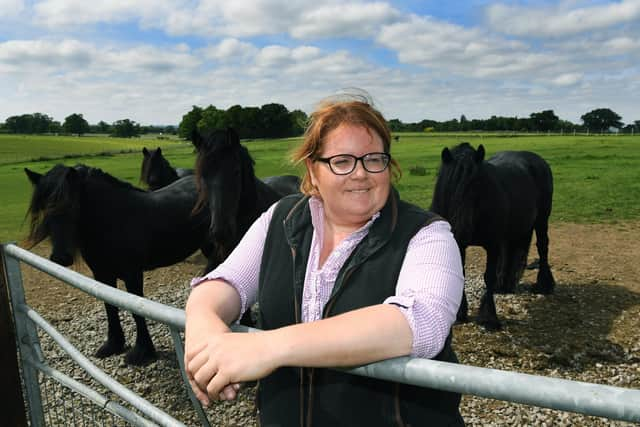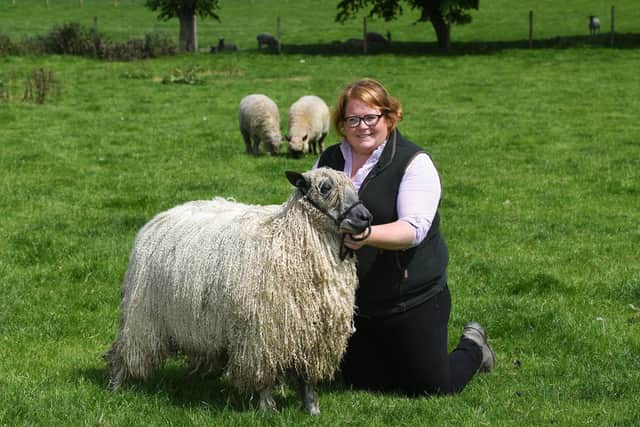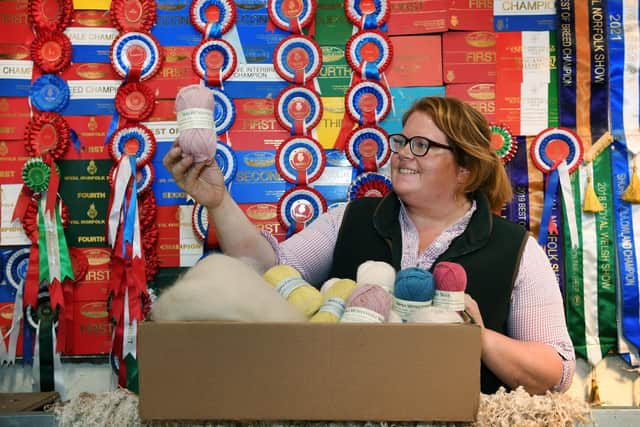Farm of the Week: Breeding secrets of the Yorkshire family with a stunning record of show wins
“Whatever you show it’s the level of detail that you go into and the long-term commitment,” says Anna Pennell from Home Farm at Brough Park near Catterick where she moved to with parents Richard and Julie and sister Laura three years ago having shifted lock, stock and bale feeder after 15 years in County Durham.
“I’ve just pulled off gimmer lambs that will be part of next year’s show team. It’s not just about increasing the quality of your flock, it’s about having that foresight to be continuously pushing.
Advertisement
Hide AdAdvertisement
Hide AdWhat that means to those who will be around the sheep pens in just over three weeks’ time is that this year’s Nipna team (Anna’s prefix) that will be at the Great Yorkshire Show was pretty much selected last year.


“You might get a few changes along the way and it’s actually quite a big team at this point, but that’s how we do it,” says Anna.
The Pennell family track record in showing is outstanding. For many years they showed their Dales Ponies and although they no longer show their breeding goes before them.
At last year’s Horse of the Year Show there were six Nipna-bred Dales Ponies in the breed Final. In more recent years Anna has turned her attention to the Wensleydale and Clun Forest sheep breeds and has had stunning success at both the Great Yorkshire and the Royal Welsh.
Advertisement
Hide AdAdvertisement
Hide AdAnna knows full well that all of the preparation in the world does not guarantee a win.


“We all have good and bad days. You have some when you think I really shouldn’t have won that, but I’m going with it, or maybe that I should have won that. You’ve just to get over it when it has perhaps not turned out the way you’d hoped.
“The thing to remember with all stock at shows is that it’s the shop window. In addition to the judge there might be 100 ringside judges and one might come over and buy something because of what is there.
Anna only started with Clun Forest in 2017 buying two ewe lambs from the Melton Mowbray sale, but in her first year showing them in 2018 she had Interbreed Reserve Champion at the Great Yorkshire and Interbreed Supreme Champion at the Royal Welsh. Last year a son of that ewe gave Anna Interbreed Reserve Champion again at the Great Yorkshire. Not bad for a breed that is relatively unknown in Yorkshire.
Advertisement
Hide AdAdvertisement
Hide Ad“I’d wanted a down breed to run alongside the Wensleydales. As I also like showing I wanted something smart.


“They are actually an upland sheep that are native to Shropshire from the town of Clun near the Welsh border.
It soon became clear that she had stumbled on a breed she could work with in producing quality meat lambs through a system of producing quality pedigrees, the Clun Mule and putting a terminal sire on to the Clun Mules.
“It was the friend I bought those initial two ewes from who then showed me his flock of Clun Mules. They are so easy, great mothers, have a great body and an all-round sheep. Fundamentally you’ve got a mother that gets on with it, has two lambs, rears them, sometimes rears three, they are milky, they are just brilliant.
Advertisement
Hide AdAdvertisement
Hide Ad“The Clun Mule is now the predominant sheep here. We are slowly replacing what we had when we came with Clun Mules with the idea being that the farm will be purely Clun Mules and pedigrees of Clun Forest and Wensleydale, plus three Bluefaced Leicester ewes to be put to the Leicester tup every other year.
“We now very rarely buy a female. We buy Clun and Wensleydale tups. We bought a Clun shearling tup from the main sale at Ludlow last year, Trewyrlod Excel, he was top price and was used on a handful at the back end last year. He and my homebred ram will be going on the majority of pedigrees this time.
Home Farm runs to 140 acres. Anna currently has 300 breeding ewes and 100 followers with the total made up of 30 pedigree Wensleydales, 60 pedigree Clun Forest and the remainder a mix of Clun Mules, some Suffolk Mules and some Texel-cross-Beltex.
“At the moment I’m using two Logie Durno tups on the Mules and they produce quite a uniform set of rams every year. I have two that produce the fat lambs that go to Darlington Mart.
Advertisement
Hide AdAdvertisement
Hide Ad“The plan is to have 250 Clun Mules, then 25 each of Clun and Wensleydale and to keep improving the Clun to produce Mule replacements. Lambing is January/February for the pedigrees and February/March for the commercials.
Anna intends sending around 450 lambs to market each year with both Clun and Wensleydale lambs not destined for breeding going into her online boxed lamb business that has been augmented with boxed pork from her Large Black pigs.
“The pure Wensleydale does not fit a supermarket spec, but has depth of flavour especially when it is a hogget. I have customers come back to me saying ‘Wow! You can’t get lamb like that in a supermarket’. We do separate Clun and Wensleydale boxes because they taste different. Wensleydale is that bit gamier and the Clun different too. I love that people are getting that.
Where the Wensleydale scores over other sheep is in its staple, its wool.
Advertisement
Hide AdAdvertisement
Hide Ad“A first fleece off a Wensleydale earns decent money. The majority of my best wool goes to two buyers in America and Canada who buy as much as they can and because of the taste being better as hoggets I run all my Wensleydale tup hoggs from birth until the following March, take a clip, then put them in meat boxes. We also get a good crimp off the Cluns. They’re never going to be a Wensleydale, but it’s a bonus.
The Large Black pigs are the latest addition.
“We’ve had pigs since we’ve been here. I’d been trying to find our pig breed to see how they were to rear and what sort of meat they make. We’ve now settled on Large Blacks. We bought two sows and a gilt from Rowan Simms at Ellingstring last summer and now have three sows, two gilts and a boar. We’ve just had our second litter. The plan is to try and have a litter every couple of months. They live in the woodland.
Home Farm has seen an amazing transformation in the past three years with the farmhouse and buildings renovated or new build, planting of 700 saplings by the road as a wildlife corridor, restoration of a lake, further 1500 plants including hornbeam, thorn, oak, purple maple, liquid amber, alder and mountain ash, the installation of bird boxes in woods and news recently of kestrel chicks and rare stock doves.
Anna has plans for a new classroom and meeting room later this summer for spinners, knitters and weavers, her sister Laura is to have a studio for her wildlife and countryside art.